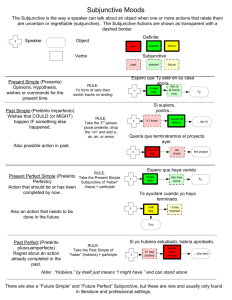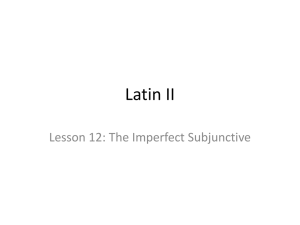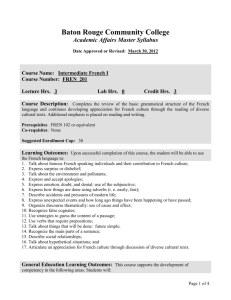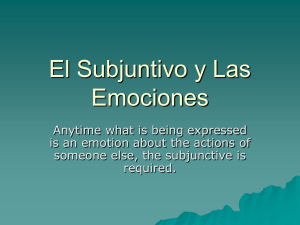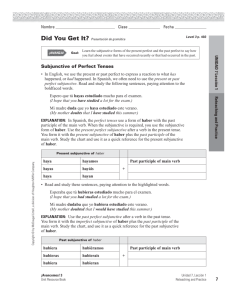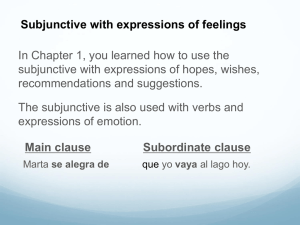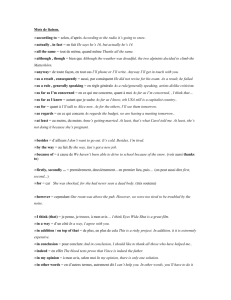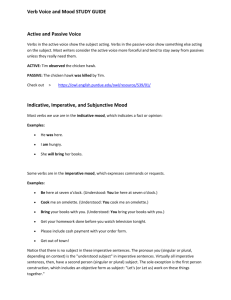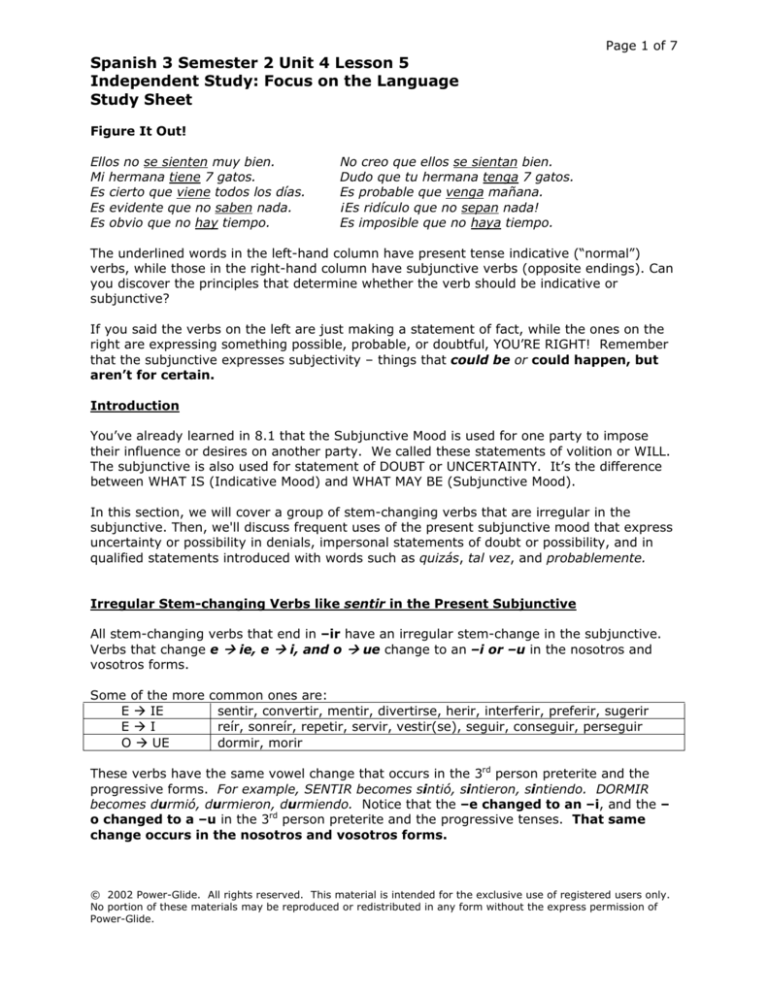
Page 1 of 7
Spanish 3 Semester 2 Unit 4 Lesson 5
Independent Study: Focus on the Language
Study Sheet
Figure It Out!
Ellos no se sienten muy bien.
Mi hermana tiene 7 gatos.
Es cierto que viene todos los días.
Es evidente que no saben nada.
Es obvio que no hay tiempo.
No creo que ellos se sientan bien.
Dudo que tu hermana tenga 7 gatos.
Es probable que venga mañana.
¡Es ridículo que no sepan nada!
Es imposible que no haya tiempo.
The underlined words in the left-hand column have present tense indicative (“normal”)
verbs, while those in the right-hand column have subjunctive verbs (opposite endings). Can
you discover the principles that determine whether the verb should be indicative or
subjunctive?
If you said the verbs on the left are just making a statement of fact, while the ones on the
right are expressing something possible, probable, or doubtful, YOU’RE RIGHT! Remember
that the subjunctive expresses subjectivity – things that could be or could happen, but
aren’t for certain.
Introduction
You’ve already learned in 8.1 that the Subjunctive Mood is used for one party to impose
their influence or desires on another party. We called these statements of volition or WILL.
The subjunctive is also used for statement of DOUBT or UNCERTAINTY. It’s the difference
between WHAT IS (Indicative Mood) and WHAT MAY BE (Subjunctive Mood).
In this section, we will cover a group of stem-changing verbs that are irregular in the
subjunctive. Then, we'll discuss frequent uses of the present subjunctive mood that express
uncertainty or possibility in denials, impersonal statements of doubt or possibility, and in
qualified statements introduced with words such as quizás, tal vez, and probablemente.
Irregular Stem-changing Verbs like sentir in the Present Subjunctive
All stem-changing verbs that end in –ir have an irregular stem-change in the subjunctive.
Verbs that change e Æ ie, e Æ i, and o Æ ue change to an –i or –u in the nosotros and
vosotros forms.
Some of the more common ones are:
E Æ IE
sentir, convertir, mentir, divertirse, herir, interferir, preferir, sugerir
EÆI
reír, sonreír, repetir, servir, vestir(se), seguir, conseguir, perseguir
O Æ UE
dormir, morir
These verbs have the same vowel change that occurs in the 3rd person preterite and the
progressive forms. For example, SENTIR becomes sintió, sintieron, sintiendo. DORMIR
becomes durmió, durmieron, durmiendo. Notice that the –e changed to an –i, and the –
o changed to a –u in the 3rd person preterite and the progressive tenses. That same
change occurs in the nosotros and vosotros forms.
© 2002 Power-Glide. All rights reserved. This material is intended for the exclusive use of registered users only.
No portion of these materials may be reproduced or redistributed in any form without the express permission of
Power-Glide.
Page 2 of 7
Spanish 3 Semester 2 Unit 4 Lesson 5
Independent Study: Focus on the Language
Study Sheet
Look at the chart below. Sentir is conjugated side by side so you can compare.
On the left are the present indicative forms, and on the right the present subjunctive forms:
PRESENT INDICATIVE OF SENTIR
SINGULAR
PLURAL
1st person
siento
sentimos
2nd person
sientes
sentís
3rd person
siente
sienten
PRESENT SUBJUNCTIVE OF SENTIR
SINGULAR
PLURAL
1st person
sienta
sintamos
2nd person
sientas
sintáis
3rd person
sienta
sientan
Now look at dormir side by side.
PRESENT SUBJUNCTIVE OF SENTIR
SINGULAR
PLURAL
1st person
duerma
durmamos
2nd person
duermas
durmáis
3rd person
duerma
duerman
PRESENT SUBJUNCTIVE OF DORMIR
SINGULAR
PLURAL
1st person
duermo
dormimos
2nd person
duermes
dormis
3rd
person
duerme
duermen
Here are a few examples of sentences that use these verbs in the present subjunctive:
Dudamos que esos jóvenes se sientan mal.
La madre desea que su bebé duerma.
Nadie quiere que sus hijos mientan.
¿Cómo quieres que nos divirtamos?
We doubt that those boys feel bad.
The mother wants her baby to sleep.
Nobody wants their children to lie.
How do you want us to have fun?
Using Present Subjunctive in Expressions of DOUBT or UNCERTAINTY
Whenever a sentence with 2 parties and 2 clauses expresses doubt, possibility, denial, or
uncertainty in the subordinate (2nd) clause, the subjunctive mood must be used.
Compare the difference between the Statements of Fact on the left where the indicative
mood is used, versus the Expressions of Doubt on the right where you must use the
subjunctive.
INDICATIVE
SUBJUNCTIVE
Es obvio que tenemos mucho trabajo.
Es probable que tengamos mucho trabajo.
It's obvious that we have a lot of work.
It’s likely that we’ll have a lot of work.
Es innegable que somos hermanos.
It's undeniable that we're brothers.
Yo dudo que ustedes sean hermanos.
I doubt you’re brothers (I think you’re joking).
No creo que ese hombre toca el piano
bien.
I don’t think that man plays very well.
(My opinion. I’ve heard him and he’s
not very good.)
No creo que ese hombre pueda tocar el piano
muy bien.
I don’t think that he can play piano very well.
(I haven’t heard him but I doubt he’s very good)
© 2002 Power-Glide. All rights reserved. This material is intended for the exclusive use of registered users only.
No portion of these materials may be reproduced or redistributed in any form without the express permission of
Power-Glide.
Page 3 of 7
Spanish 3 Semester 2 Unit 4 Lesson 5
Independent Study: Focus on the Language
Study Sheet
Negation/Doubt. If the statement denies a fact or expresses doubt about it, the
subjunctive is required. Some common subjunctive indicators are:
Dudar
to doubt
No creer
to not believe, or disbelieve
No pensar
to not think, or disbelieve
Negar
to deny, or refuse to believe
There are also impersonal expressions that begin with “It’s...” that express doubt or
uncertainty such as...
Es dudable
It’s doubtful
Es imposible
It’s impossible
No es cierto
It’s not true
Es increíble
It’s unbelievable, It’s incredible
Mentira
No way (It’s a lie)
Remember that the impersonal expression acts as the 1st party.
“It” is the subject, and the impersonal expression must be followed
by que and the subordinate subjunctive clause.
Examples:
Es imposible que tengas 18 años.
No es cierto que seamos tontos.
¡Mentira que tengas amigos franceses!
You couldn't be 18 years old.
It's not true that we're foolish.
No way do you have French friends!
However, impersonal statements such as “Es cierto” and “Es verdad” do NOT take the
subjunctive because they express facts. Compare the difference below.
Es cierto que no hemos terminado todavía.
No es cierto que haya terminado la tarea.
Stating a fact; indicative verb
Negation; subjunctive verb
Also, if a "denial" verb is used negatively to create a clearly affirmative statement, it
becomes a statement of fact and consequently, takes the indicative (normal) ending.
No dudamos que es cierto lo que dice.
We don't doubt that what he says is true.
Possibility/Probability. When there is potential for something to occur but it hasn’t
happened yet, in other words, there is the possibility that a future event may or may not
take place, these statements take the subjunctive. This is all part of the Latino “si Dios
quiere” culture and attitude. “God willing,” the event will occur, but anything could happen
between now and the actual event. For example:
Es probable
It’s probable (but not certain)
Es posible
It’s possible (but then again, anything is possible)
Quizás
Perhaps, Maybe
Tal vez
Perhaps, Maybe
Probablemente
Probably
Examples:
Es probable que vengan mañana.
It's likely that they'll come tomorrow.
© 2002 Power-Glide. All rights reserved. This material is intended for the exclusive use of registered users only.
No portion of these materials may be reproduced or redistributed in any form without the express permission of
Power-Glide.
Page 4 of 7
Spanish 3 Semester 2 Unit 4 Lesson 5
Independent Study: Focus on the Language
Study Sheet
Es posible que tengamos uno.
(But it’s not 100% -- something may prevent
them from showing up)
It's possible that we might have one.
(There is some doubt in the speaker’s mind.)
Whether to use Subjunctive or Indicative after probablemente, quizás and tal vez
Remember that whether you use the subjunctive or indicative depends on what the speaker
means to say. By using a subjunctive verb after probablemente, quizás, or tal vez, the
speaker indicates that something is unlikely or doubtful. When the speaker uses the
indicative, it means he’s about 99% sure that it will happen.
By using phrases such as probablemente, quizás and tal vez, it’s possible to create a
sentence that indicates probability without even using a subordinate clause. In other words,
you don’t need two clauses joined by a que when using these 3 words.
Posiblemente el problema radica en tu actitud. INDICATIVE
Possibly the problem is with your attitude. (The speaker believes that truly is the
problem. There is little doubt in his/her mind.)
Eso viene del gobierno tal vez. INDICATIVE
That might be coming from the government. (The speaker feels confident in his
assumption)
Posiblemente tenga yo la culpa. SUBJUNCTIVE
Possibly it's my fault. (But the speaker doesn’t want to pin all the blame on himself.)
Quizás venga. SUBJUNCTIVE
Perhaps he will come. (Because it’s in the future, there is definite uncertainty.)
Here are some guidelines to follow:
1. Position of the Word or Phrase of Probability.
If the phrase tal vez, quizá or probablemente comes after the verb, then the verb
must remain indicative. For example:
Es, quizás, la única opción que nos queda.
It is perhaps the only option we have left.
Come cinco veces al día, tal vez.
He eats five times a day, maybe.
There is little doubt in both of these sentences. It is more likely than not.
2. Reference to the Future. A future event or occurance is an automatic indicator
that there is doubt or possibility of not happening. Remember the “Si Dios Quiere”
attitude that anything could happen to prevent the event from coming about.
Probablemente no pase nada.
Probably nothing will happen.
Quizá se adopte la nueva moda.
© 2002 Power-Glide. All rights reserved. This material is intended for the exclusive use of registered users only.
No portion of these materials may be reproduced or redistributed in any form without the express permission of
Power-Glide.
Page 5 of 7
Spanish 3 Semester 2 Unit 4 Lesson 5
Independent Study: Focus on the Language
Study Sheet
Maybe the new style will be adopted.
Hoy no sabemos, pero mañana tal vez sepamos.
We don't know today, but tomorrow perhaps we'll know.
Summary
•
Verbs like sentir, repetir, and dormir (present tense stem-changers) ie or ue in all
conjugations in the subjunctive except for the first person plural (nosotros) and
second person plural (vosotros), where it changes to i and u respectively.
•
The present subjunctive is used statements expressing doubt, negation, possibility or
probability. Impersonal statements of fact, like “es cierto” do not use the subjunctive
mood.
•
Finally, the present subjunctive and indicative are used in sentences that are not
subordinate clauses, but are statements qualified with words such as probablemente,
quizá, and tal vez.
Practice Questions
A. Fill in the blanks: Present Subjunctive of stem-changing verbs
Write the meaning of the verb next to the infinitive. Then write the correct form of the
present subjunctive after each subject. Remember to change the stem accordingly.
1. morir
=__________________
yo
________
Ud
________
Ella
________
nosotros
________
2. pedir
=__________________
tú
________
Ud.
________
nosotros
________
yo
________
3. divertirse =__________________
nosotros
________
yo
________
Uds.
________
vosotros
________
4. conseguir =__________________
nosotros
________
tú
________
ella
________
yo
________
© 2002 Power-Glide. All rights reserved. This material is intended for the exclusive use of registered users only.
No portion of these materials may be reproduced or redistributed in any form without the express permission of
Power-Glide.
Page 6 of 7
Spanish 3 Semester 2 Unit 4 Lesson 5
Independent Study: Focus on the Language
Study Sheet
5. dormir
=__________________
yo
________
ella
________
nosotros
________
ellos
________
6. mentir
= ___________________
nosotros
________
ellos
________
vosotros
________
yo
________
7. sonreír
=___________________
nosotros
________
yo
________
ellas
________
tú
________
8. preferir
=___________________
yo
________
tú
________
nosotras
________
ellas
________
B. Indicative or Subjunctive in Impersonal Expressions?
1. Es imposible que (tienes, tengas) 18 años.
2. Es posible que (hay, haya) muchas personas allí.
3. Es dudable que (vas, vayas) a llegar a tiempo a clase.
4. Es cierto que (viven, vivan) muchos habitantes en Lima, Perú.
5. Es la verdad que Carlos (habla, hable) con un acento de Madrid.
6. No es cierto que (somos, seamos) tontos.
7. Es inconcebible
(inconceivable)
que ese muchacho (dibuja, dibuje) igual que Picasso.
8. Es obvio que ella (es, sea) buena profesora.
9. Es verdad que la clase (empieza, empiece) a la una.
10. Es mentira que yo (prefiero, prefiera) el helado a los caramelos.
© 2002 Power-Glide. All rights reserved. This material is intended for the exclusive use of registered users only.
No portion of these materials may be reproduced or redistributed in any form without the express permission of
Power-Glide.
Page 7 of 7
Spanish 3 Semester 2 Unit 4 Lesson 5
Independent Study: Focus on the Language
Study Sheet
C. Changing Moods
Change the sentence from a statement of fact to a sentence expressing doubt or
uncertainty by using the subjunctive indicator in parenthesis.
1.
Ellos no se sienten muy bien. (Es probable)
__________________________________________________________________
2.
Mi amigo siempre miente. (Es dudoso)
__________________________________________________________________
3.
Los padres no saben nada. (Es ridículo)
__________________________________________________________________
4.
Nosotros servimos el postre antes de la cena. (No creo)
___________________________________________________________________
5.
Nosotros nos vestimos después de ducharnos. (Es probable)
___________________________________________________________________
6.
Yo consigo los boletos para el concierto. (Ellos no piensan)
___________________________________________________________________
D. Translation
Use the subjunctive in each of the following expressions of Doubt, Negation, or Possibility
1.
I doubt that you (tú) can change.
___________________________________________________________________
2.
I don’t believe that you (Ud.) are telling the truth.
__________________________________________________________________
3.
I refuse to believe that you (tú) have eleven toes.
___________________________________________________________________
4.
It’s possible for you (Uds.) to be rich.
___________________________________________________________________
5.
It’s unbelievable that you (Ud.) drive a Mazuradi.
___________________________________________________________________
© 2002 Power-Glide. All rights reserved. This material is intended for the exclusive use of registered users only.
No portion of these materials may be reproduced or redistributed in any form without the express permission of
Power-Glide.

